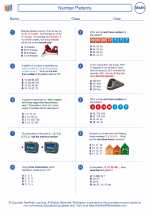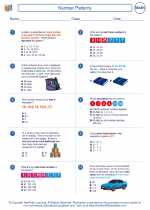Sequences
A sequence is a list of numbers or objects in a specific order. Each number or object in the sequence is called a term. The terms in a sequence can be identified by their position, or index, in the sequence. For example, the sequence 2, 4, 6, 8, 10 is a list of even numbers in ascending order.
Types of Sequences
There are several types of sequences, including arithmetic sequences, geometric sequences, and more. Let's take a closer look at each type:
Arithmetic Sequences
An arithmetic sequence is a sequence in which each term after the first is found by adding a constant value to the previous term. This constant value is called the common difference. For example, the sequence 3, 6, 9, 12, 15 is an arithmetic sequence with a common difference of 3.
Geometric Sequences
A geometric sequence is a sequence in which each term after the first is found by multiplying the previous term by a constant value. This constant value is called the common ratio. For example, the sequence 2, 6, 18, 54, 162 is a geometric sequence with a common ratio of 3.
Study Guide
Here are some key points to remember when studying sequences:
- Identify the type of sequence: Determine whether the sequence is arithmetic, geometric, or another type.
- Find the common difference or common ratio: For arithmetic sequences, find the constant value added to each term. For geometric sequences, find the constant value by which each term is multiplied.
- Write the explicit formula: Use the explicit formula to find any term in the sequence based on its position.
- Calculate the nth term: Use the explicit formula to find the value of any term in the sequence without having to list all the preceding terms.
- Understand the concepts: Make sure to understand the concepts of sequences, including terms, position, common difference, common ratio, and explicit formula.
Practice solving problems involving arithmetic and geometric sequences to reinforce your understanding of the concepts.
Conclusion
Sequences are an important concept in mathematics and are used in various real-world applications. By understanding the different types of sequences and how to work with them, you can develop strong problem-solving skills and apply them to a wide range of mathematical problems.
[Sequences] Related Worksheets and Study Guides:
.◂Math Worksheets and Study Guides Sixth Grade. Number Patterns

 Worksheet/Answer key
Worksheet/Answer key
 Worksheet/Answer key
Worksheet/Answer key
 Worksheet/Answer key
Worksheet/Answer key
